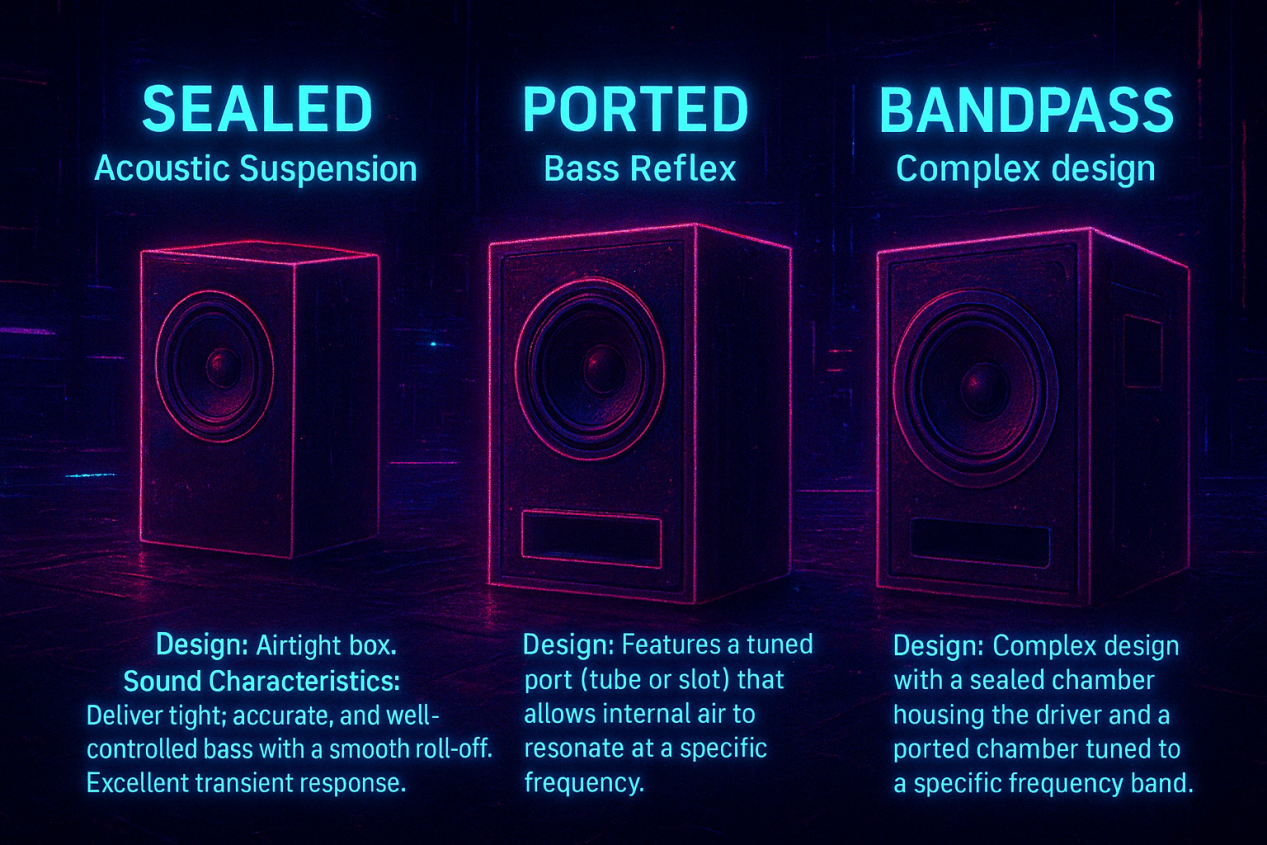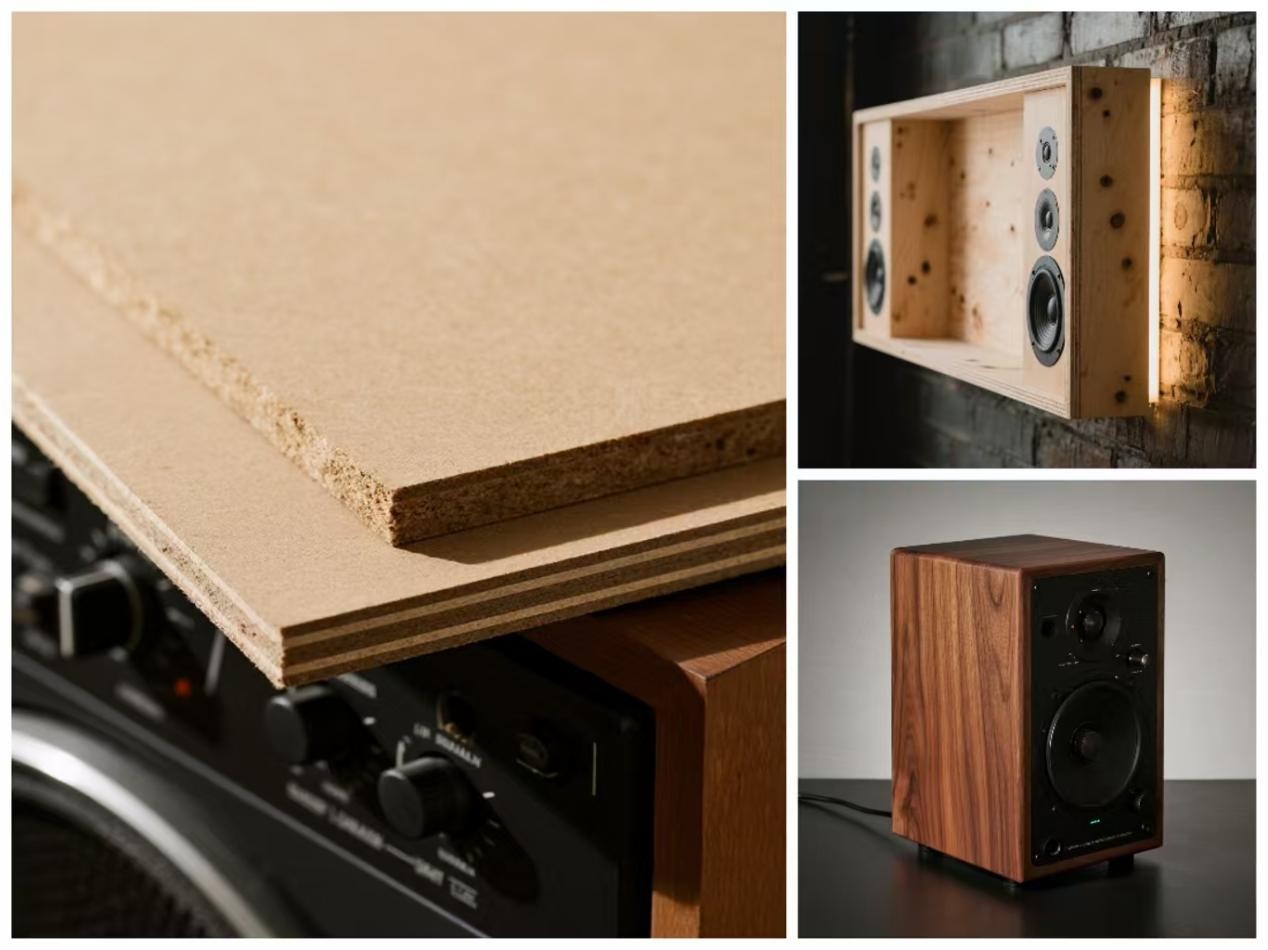The loudspeaker enclosure constitutes a critical acoustic transducer component rather than a mere containment vessel. Its structural design and material selection directly govern three core performance metrics:
- Acoustic radiation efficiency through controlled air compliance
- Frequency response characteristics shaped by internal damping and resonance control
- Transient distortion mitigation via optimized internal bracing configurations.
Understanding Enclosure Types: Shaping the Sound Waves

Contemporary loudspeaker engineering recognizes three fundamental transduction paradigms, each exhibiting distinct acoustic signatures:
Sealed Box(Sealed Container)
- Appearance: A completely enclosed box body
- Feature: Deep bass is solid and clear, with fast response
- Disadvantage: Requires greater power for propulsion
- Suitable for: Audiophiles with high requirements for sound quality / Use in small spaces
Ported (Bass Reflex) Enclosures
- Feature: tuned ports (tube-shaped or slot-shaped), which enable the internal air to resonate at specific frequencies
- Appearance:There are one or more ports (holes or slots) on the enclosure, usually located on the front, rear, or sides
- Note: May be accompanied by airflow sounds
- Suitable for: Especially suitable for subwoofers and applications where extended bass output is desired
Tunnel Type (Bandpass Enclosure)
- Structure: Special dual-chamber design
- Feature: Strong burst power in specific frequency band
- Limitation: Narrow frequency response range
The constituent material selection constitutes a determinant factor in establishing both acoustic transfer characteristics and mechanical stability thresholds of enclosure systems.
The harder the cabinet, the higher the density, and the purer the sound. However, if it is too rigid, resonance may occur. Professional speakers will balance the resonance effect through internal damping materials to make the sound more natural.
How to choose the material for the subwoofer enclosure?
The material properties of density, elastic modulus, and viscoelastic damping characteristics fundamentally determine the enclosure’s vibrational modes, thereby shaping its acoustic signature through resonant energy dissipation mechanisms.

medium Density Fiberboard (MDF)
The most commonly used “all-purpose board” in the industry
★Feature
- As dense as compressed biscuits, with affordable prices and easy to process
- Mechanical resilience enables absorption of environmental stressors, whereas moisture susceptibility induces volumetric expansion through capillary action in porous matrices.The weight is comparable to that of fitness equipment. Be careful when moving it.
★ Sound Effects Performance
- The standard monitoring role operates as a passive signal path element, maintaining strict acoustic fidelity through zero artificial enhancement protocols while preserving original source integrity.
- Engineering-grade apparatus engineered for operational reliability in harsh environments, incorporating shock-resistant chassis and MIL-STD-810G certified shock/dust/water resistance
Beech Plywood (from the Baltic Sea)
★ Feature
- Advanced Waterproof Warrior
- Lighter and stronger than MDF, with a built-in moisture-proof shield
- The surface is smooth, as if it has been coated with a protective film.
Critical consideration must be given to internal cavity detection in lumber selection, as undocumented voids may compromise structural integrity and serviceability through stress concentration mechanisms
★ Sound Effects Performance
- Add a touch of “vitality” to the MDF.
- The bass has more elasticity and is suitable for energetic music.
- The price is a bit high, but economical.
Solid Wood (Hickory Wood / Maple Wood)
The elite of the speaker world
★ Feature
- The natural wood grain comes with its own premium filter effect.
- Steadfast as a rock but delicate and difficult to take care of
- Changes in humidity can cause cracking, and professional maintenance is required.
★ Sound Effects Performance:
- The deep and resonant bass sound like that of an ancient zither
- With the warm texture characteristic of wood
Ideal for enthusiasts’ collection, but cautious when used daily.
Purchase Tips:
- In humid areas, choose plywood first.
- Use lightweight MDF for moving.
- Solid wood speakers need to be paired with a constant temperature and humidity cabinet.
- Don’t believe the “purely solid wood” claims. Most of them are actually veneer work.
Pastics (ABS, Polycarbonate)
A lightweight and practical “tech-savvy” device
★ Feature
- This engineering-grade polymer exhibits structural malleability comparable to LEGO® brick systems, enabling the creation of complex geometries through precision injection molding processes, including aerodynamic profiles and negative space configurations with ±0.1mm dimensional tolerances
- The waterproof and dustproof performance is comparable to that of a submarine. You can build it outdoors even on rainy days.
- Low production cost, common in the market are smart speakers priced at hundreds of RMB.
★ Sound Effects Performance
- Old-fashioned plastic speakers often have an “electronic flavor”. Now, by adding “anti-vibration frame” and sound-absorbing cotton, the sound quality has been significantly improved. For example, a certain Xiaomi speaker uses honeycomb structure + shock-absorbing particles, and the depth of low-frequency sound penetration has increased by 30%.
Metal (Aluminum, Steel)
The “hardcore toy” of audiophiles
★ Feature
- The aluminum body is as exquisite as that of an iPhone, while the steel box is comparable to an insurance cabinet. It dissipates heat quickly and is suitable for long-term high-volume work.
- The processing cost is three times that of plastic.
★ Sound Effects Performance
- The high-frequency is as clear as crystal, and the human voice is so distinct that one can even hear the breathing sounds. However, the low-frequency requires special adjustment. A certain brand of monitoring speakers has cotton padding inside the cabinet to prevent the bass from being too overpowering.
Applicable scenarios: Professional recording studio monitoring speakers High-end portable Bluetooth speaker (such as B&O Beosound A1) Car audio system modification (metal box body anti-resonance)
Other Materials (Stone, Concrete, Glass)
An artist’s experimental creation
Material Reference:
- Granite speaker: Weighing 200 pounds, the bass is so powerful it sounds like thunder.
- Glass speaker: The transparent body allows you to see the internal diaphragm. It is fragile and requires careful handling.
- Concrete speaker: Construction-style design, requires filling with sound insulation materials
Special use:
A speaker made by a certain audiophile using marble carving, with mid-frequency density comparable to tube amplifiers, but it requires four people to carry during transportation.
Purchase Tips:
- For outdoor use, ABS plastic is the preferred choice (it is shockproof and water-resistant)
Pursuing HiFi sound quality, the aluminum alloy cabinet is adopted. - For stone or glass speakers, it is recommended to choose the brand’s custom-made models.Be aware that the metal box may produce a “metallic sound”. Please listen to it before making a purchase.
Making the Right Choice: Balancing Needs and Constraints
Ultimate Guide to Speaker Selection: Find Your “Sound Partner”
Core requirement:
- To achieve CD-level precise sound quality
Box selection:
- Sealed box (pressurized container): It’s like locking the sound in an insurance box. The bass is solid and not loose.
- High-end inverted box (funnel type): Equipped with a bass boost chamber, providing a spacious and layered sound field.
Material Code:
- Medium-density fiberboard (MDF): The “Lego blocks” of the audio equipment industry, easy to process and naturally soundproof.
- Nordic Birch Plywood: Comes with a natural wood grain filter, with a tone as smooth and lustrous as jade.
- Solid wood (oak/ash): The “guardian treasure” for audiophiles, each piece has its unique wood grain pattern.
Applicable scenarios:
- The starry ceiling of the home theater
- The HiFi music corner in the study
- The Mobile Castle of Digital Music Enthusiasts
Conclusion
Similar to footwear selection requiring environmental adaptability, acoustic system selection mandates rigorous scenario-based evaluation.
Remember: There is no perfect speaker; only the one that suits you best as your “sound partner”. Next time when making a purchase, you might as well bring a demo of the music you often listen to to the physical store for a trial listening. Let your ears vote for it!
